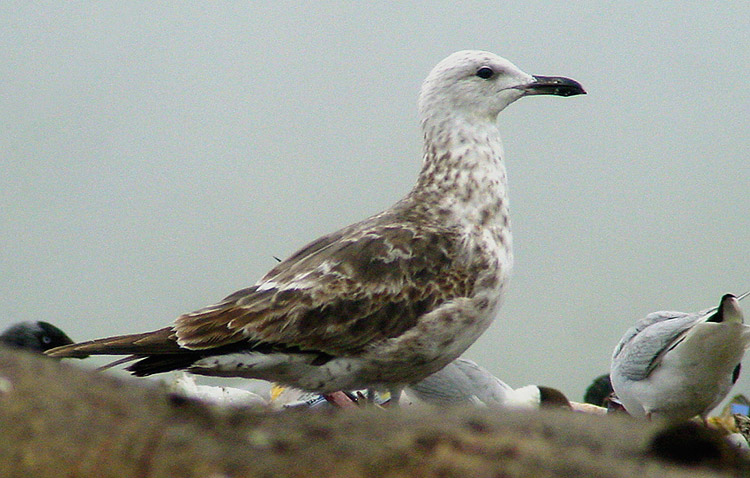Larus fuscus fuscus / intermedius 2cy, July 12 2003, Tampere, Finland (61.33N 24.59E).

Some 2cy birds on the Tampere dump in Finland in July show characteristics which normally do not associate with classic fuscus. Here is an individual which much resembles graellsii / intermedius, with very restricted post-juvenile moult. By mid-July, the outer primaries (P5-P10) are still juvenile. All rectrices are juvenile as well and probably the complete moult in the flight feathers will take place in an ordinary sequence and timing as in western relatives intermedius / graellsii.
All the scapulars were included in the post-juvenile moult on the wintering ground. The scapulars show a mix of old and new feathers (in the lower upper scapulars); the new scapulars appear plain slate-grey without obvious pattern, just slightly paler grey than average 2cy fuscus. The old second generation scapulars have an obvious pattern of bars and an accentuated shaft-streak.
In the wing-coverts, at least one central median covert and one inner lower lesser covert were replaced on the wintering ground before May. After arrival in Scandinavia, moult started in the outer median and lower lesser coverts; the fresh feathers slate-grey without obvious pattern. The upper tertial is replaced and the second tertial is growing; the innermost greater coverts is replaced as well. Most other wing-coverts are still juvenile. This is approximately the schedule, which can also be found in intermedius. The bare parts are still immature: the bill is dark, the legs are pink and the iris is dark.
Moult score overlaps with average intermedius/graellsii in July in NW Europe (see July section), but see e.g. this advanced LBBG in the Netherlands, with P6 fully grown and P7 growing.
Typical Finnish fuscus in July have replaced primaries, rectrices and secondaries, all moulted in a complete post-juvenile moult on the wintering grounds, prior to northbound migration. The new second generation primaries are only a couple of months old and still look dark blackish. The second generation tail-feathers normally still show the white tips, but in some individuals these tips are worn away when 2cy birds arrive back in Scandinavia. Immediately after returning in Scandinavia some 2cy fuscus start a new moult cycle in the inner primaries, now growing in third generation feathers.
The complete moult in the winter quarters normally start with replacement of the scapulars and mantle-feathers in November to January, but the post-juvenile moult may already start in juvenile birds which are still in Scandinavia in September. The new scapulars often show a simple pattern of a black shaft-streak on a dark brown base. When most of the scapulars are replaced, fuscus start to replace the wing-coverts, in the ordinary sequence that can also be found in other gull taxa in Europe. Wing-covert moult is initiated in two loci, one wave starts in the outermost coverts, one wave starts in the innermost coverts. The two waves normally meet at covert #7-8. Normally the median covert row is the first row which is moulted, followed by the lower lesser coverts, the greater coverts and moult finishes in the outer lesser coverts (the carpal edge). If for whatever reason, moult in the wing-coverts is arrested, this is normally most obvious in the carpal edge and outer greater coverts, containing juvenile feathers which contrast with the other fresh coverts.
In classical 2cy fuscus, all wing-coverts are replaced to second generation on the wintering grounds, and by mid July in Scandinavia, a next moult wave is initiated, often including the median and lower lesser coverts, the inner greater coverts, upper tertials and scapulars. Bare part coloration may be very immature, including a black bill, but may also be very mature, with a yellow base and a red gonydeal spot on the lower mandible. Still, these birds are only 12 months old.
|
 nominate Lesser Black-backed Gull (L. fuscus)
nominate Lesser Black-backed Gull (L. fuscus)